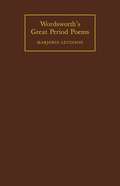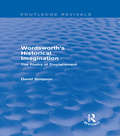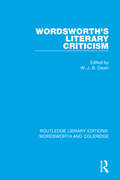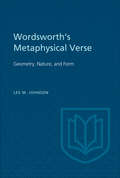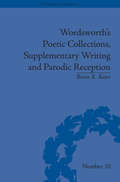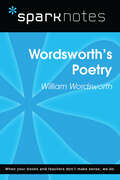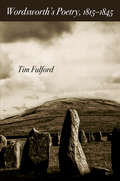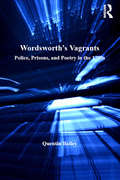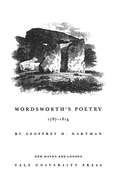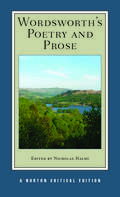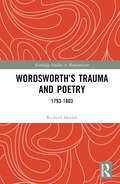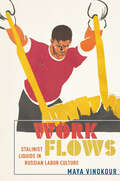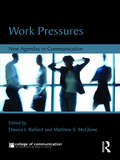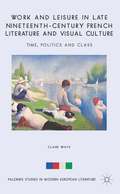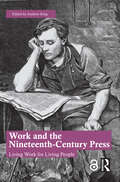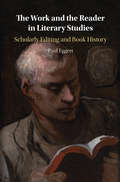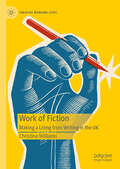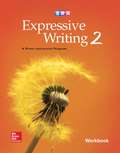- Table View
- List View
Wordsworth's Great Period Poems: Four Essays
by Marjorie LevinsonThe book presents four major poems from Wordsworth's great period of creativity, 1798-1805: Tintern Abbey, Michael, The Intimations Ode, Peele Castle.
Wordsworth's Historical Imagination: The Poetry of Displacement (Routledge Revivals)
by David SimpsonTraditionally, Wordsworth’s greatness is founded on his identity as the poet of nature and solitude. The Wordsworthian imagination is seen as an essentially private faculty, its very existence premised on the absence of other people. In this title, first published in 1987, David Simpson challenges this established view of Wordsworth, arguing that it fails to recognize and explain the importance of the context of the public sphere and the social environment to the authentic experience of the imagination. Wordsworth’s preoccupation with the metaphors of property and labour shows him to be acutely anxious about the value of his art in a world that he regarded as corrupted. Through close examination of a few important poems, both well-known and relatively unknown, Simpson shows that there is no unitary, public Wordsworth, nor is there a conflict or tension between the private and the public. The absence of any clear kind of authority in the voice that speaks the poems makes Wordsworth’s poetry, in Simpson’s phrase, a ‘poetry of displacement’.
Wordsworth's Literary Criticism (RLE: Wordsworth and Coleridge #13)
by W. J. B. OwenFirst published in 1974. Wordsworth, with Coleridge, is the major literary critic of the Romantic period. This volume assembles all of Wordsworth’s formal critical writings and a selection of critical comments from his correspondence. These documents are invaluable for Romantic poetry at large, and his theories — particularly on poetic diction, ordinary language and the nature of the creative process — inspired lively critical debate. This book discusses the nature and origin of Wordsworth’s criticism in general, and the literary tradition from which they sprang. The texts are succinctly annotated and there is a select bibliography. This book will be of interest to students of literature.
Wordsworth's Metaphysical Verse: Geometry, Nature, and Form
by Lee JohnsonIn his philosophic verse, Woodsworth identifies the history of poetry and geometrical thought as the two chief treasures of the mind and as main sources of his poetic inspiration. He assigns transcendental value to geometry and indicates that he attempts to apply its proportions to the laws of nature. In this book, Professor Johnson demonstrates how Wordsworth also employed geometrical patterns in the metrical construction of his verse and how the character of those patterns can be related to the poet's major philosophical values. Johnson shows how Wordsworth, when writing about the nature and significance of geometrical thought in The Prelude and The Excursion, designs his verse paragraphs in accordance with simple geometrical proportions which are thereby associated with the metaphysical value he attributes to geometry. Wordsworth finds geometrical forms to be hidden in the natural landscape and inherent in the structures of perception itself. This book is the first to make a sustained description of Wordsworth's symbolic patterns and metrical forms in his philosophic verse, with major examples drawn from Tintern Abbey, The Prelude, The Excursion, and the Immortality Ode. Although it presents an approach which differs radically from any in the established criticism of the poet, it is basically at one with the large body of work that concerns the nature of Wordsworth's imagination.
Wordsworth's Poetic Collections, Supplementary Writing and Parodic Reception (The History of the Book #10)
by Brian R BatesWordsworth’s process of revision, his organization of poetic volumes and his supplementary writings are often seen as distinct from his poetic composition. Bates asserts that an analysis of these supplementary writings and paratexts are necessary to a full understanding of Wordsworth’s poetry.
Wordsworth's Poetry (SparkNotes Literature Guide Series)
by SparkNotesWordsworth's Poetry (SparkNotes Literature Guide) by William Wordsworth Making the reading experience fun! Created by Harvard students for students everywhere, SparkNotes is a new breed of study guide: smarter, better, faster. Geared to what today's students need to know, SparkNotes provides: *Chapter-by-chapter analysis *Explanations of key themes, motifs, and symbols *A review quiz and essay topicsLively and accessible, these guides are perfect for late-night studying and writing papers
Wordsworth's Poetry, 1815-1845 (Haney Foundation Series)
by Tim FulfordThe later poetry of William Wordsworth, popular in his lifetime and influential on the Victorians, has, with a few exceptions, received little attention from contemporary literary critics. In Wordsworth's Poetry, 1815-1845, Tim Fulford argues that the later work reveals a mature poet far more varied and surprising than is often acknowledged. Examining the most characteristic poems in their historical contexts, he shows Wordsworth probing the experiences and perspectives of later life and innovating formally and stylistically. He demonstrates how Wordsworth modified his writing in light of conversations with younger poets and learned to acknowledge his debt to women in ways he could not as a young man. The older Wordsworth emerges in Fulford's depiction as a love poet of companionate tenderness rather than passionate lament. He also appears as a political poet—bitter at capitalist exploitation and at a society in which vanity is rewarded while poverty is blamed. Most notably, he stands out as a history poet more probing and more clear-sighted than any of his time in his understanding of the responsibilities and temptations of all who try to memorialize the past.
Wordsworth's Vagrants: Police, Prisons, and Poetry in the 1790s (British Literature In Context In The Long Eighteenth Century Ser.)
by Quentin BaileyWordsworth's Vagrants explores the poet's treatment of the 'idle and disorderly' in the context of the penal laws of the 1790s, when the terror of the French Revolution caused a crackdown on the beggars and vagrants who roamed the English countryside. From his work on the Salisbury Plain poems through to the poetry about vagrants, beggars, and lunatics in Lyrical Ballads, Quentin Bailey argues, Wordsworth attempted to imagine a way of relating to the vagrant and criminal poor that could challenge the systematizing impulses of William Pitt and Jeremy Bentham. Whereas writers had previously relied on sensibility and fellow-feeling to reveal the correct ordering of society, Wordsworth was writing in a period in which legislators, magistrates, and commentators agreed that a more aggressively interventionist approach and new institutional solutions were needed to tackle criminality and establish a disciplined and obedient workforce. Wordsworth's interest in individual psychology and solitude, Bailey suggests, grew out of his specific awareness of the Bloody Code and the discussions surrounding it. His study offers a way of reading Wordsworth's poetry that is sensitive to his early radicalism but which does not equate socio-political engagement solely with support for the French Revolution.
Wordsworth’s Poetry 1787-1814
by Geoffrey HartmanThe drama of consciousness and maturation in the growth of a poet's mind is traced from Wordsworth's earliest poems to The Excursion of 1814. Mr. Hartman follows Wordsworth's growth into self-consciousness, his realization of the autonomy of the spirit, and his turning back to nature. The apocalyptic bias is brought out, perhaps for the first time since Bradley's Oxford Lectures, and without slighting in any way his greatness as a nature poet. Rather, a dialectical relation is established between his visionary temper and the slow and vacillating growth of the humanized or sympathetic imagination. Mr. Hartman presents a phenomenology of the mind with important bearings on the Romantic movement as a whole and as confirmation of Wordsworth's crucial position in the history of English poetry. Mr. Hartman is professor of English and comparative literature at the University of Iowa. "A most distinguished book, subtle, penetrating, profound."--Rene Wellek. "If it is the purpose of criticism to illuminate, to evaluate, and to send the reader back to the text for a fresh reading, Hartman has succeeded in establishing the grounds for such a renewal of appreciation of Wordsworth."--Donald Weeks, Journal of Aesthetics and Art Criticism.
Wordsworth’s Poetry and Prose
by Nicholas HalmiThis Norton Critical Edition presents a generous selection of William Wordworth's poetry (including the thirteen-book Prelude of 1805) and prose works along with supporting materials for in-depth study. Together, the Norton Critical Editions of Wordsworth's Poetry and Prose and The Prelude: 1799, 1805, 1850 are the essential texts for studying this author. Wordsworth's Poetry and Prose includes a large selection of texts chronologically arranged, thereby allowing readers to trace the author's evolving interests and ideas. An insightful general introduction and textual introduction precede the texts, each of which is fully annotated. Illustrative materials include maps, manuscript pages, and title pages. "Criticism" collects thirty responses to Wordsworth's poetry and prose spanning three centuries by British and American authors. Contributors include Samuel Taylor Coleridge, Percy Bysshe Shelley, Felicia Hemans, Ralph Waldo Emerson, Lucy Newlyn, Stephen Gill, Neil Fraistat, Mary Jacobus, Nicholas Roe, M. H. Abrams, Karen Swann, Michael O'Neill, and Geoffrey Hartman, among others. The volume also includes a Chronology, a Biographical Register, a Selected Bibliography, and an Index of Titles and First Lines of Poems.
Wordsworth’s Trauma and Poetry: 1793–1803 (Routledge Studies in Romanticism)
by Richard E. MatlakBased upon the testimony of Thomas Carlyle, most biographers acknowledge that Wordsworth witnessed the beheading of the journalist Antoine Gorsas in October 1793 during the Reign of Terror. But they go no further. This study reads the Poet’s reactions to the Terror in passages from The Prelude as explicitly about his twenty-three-year-old-self witnessing the gory deaths of Gorsas and others, which caused post-traumatic stress disorder and its symptoms, exacerbated by guilt for abandoning his French lover and their child a year earlier. Following a chronological arc from October 1793, when the trauma began, until its conclusion in October 1803, when Wordsworth became a poet-soldier, I examine poetic works from The Borderers (1796), the “Discharged Soldier’ (1798), the Two-Part Prelude (1799), Home at Grasmere (1800), and the Liberty sonnets (1803), to follow the Poet working through anxiety, fear, and remorse to a resolution.
Wordwatching: Breaking into the Dictionary: It's His Word Against Theirs
by Alex HorneAlex Horne loves words. He loves them so much, in fact, that he's decided to invent his own ... and get them into the dictionary. But, as Alex discovers, gaining entry into the official lexicon takes more than just a gentle word in the ear of the editor. Evidence is required - Alex needs proof that his words are being spoken by more people than just him and his mum. He needs what the dictionary authorities call a 'corpus' of examples, hard data showing that his new words are in widespread and long-term usage. So a corpus he resolves to create, no matter what obstacles he might meet on the way. This is the epic and ridiculous story of one man's struggle to break into the dictionary. From covert word-dropping on Countdown to wilfully misinforming schoolchildren, Alex tries it all in his quest for dictionary-based immortality. Does he succeed? Are you already using one of Alex's words without realising it? You won't regret spending your hard-earned honk on this hugely entertaining book.
Work Flows: Stalinist Liquids in Russian Labor Culture (NIU Series in Slavic, East European, and Eurasian Studies)
by Maya VinokourWork Flows investigates the emergence of "flow" as a crucial metaphor within Russian labor culture since 1870. Maya Vinokour frames concern with fluid channeling as immanent to vertical power structures—whether that verticality derives from the state, as in Stalin's Soviet Union and present-day Russia, or from the proliferation of corporate monopolies, as in the contemporary Anglo-American West. Originating in pre-revolutionary bio-utopianism, the Russian rhetoric of liquids and flow reached an apotheosis during Stalin's First Five-Year Plan and re-emerged in post-Soviet "managed democracy" and Western neoliberalism.The literary, philosophical, and official texts that Work Flows examines give voice to the Stalinist ambition of reforging not merely individual bodies, but space and time themselves. By mobilizing the understudied thematic of fluidity, Vinokour offers insight into the nexus of philosophy, literature, and science that underpinned Stalinism and remains influential today. Work Flows demonstrates that Stalinism is not a historical phenomenon restricted to the period 1922-1953, but a symptom of modernity as it emerged in the twentieth century. Stalinism's legacy extends far beyond the bounds of the former Soviet Union, emerging in seemingly disparate settings like post-Soviet Russia and Silicon Valley.
Work Pressures: New Agendas in Communication (New Agendas in Communication Series)
by Dawna Ballard Matthew McGloneWork Pressures fills the void of research on the nature of pressures on individuals in the workplace. It offers a broad view of how work pressures can compromise the performance and vitality of individuals and their organizations. The contributions to this volume not only confirm communication’s centrality to the problems work pressures pose, but also open an interdisciplinary conversation about how to learn from and, ultimately, manage them. Specific topics covered include the proliferation of communication technologies, organizational discourse, work overload, and generational differences in the workplace.
Work and Leisure in Late Nineteenth-Century French Literature and Visual Culture
by Claire WhiteIn this engaging new study, Claire White reveals how representations of work and leisure became the vehicle for anxieties and fantasies about class and alienation, affecting, in turn, the ways in which writers and artists understood their own cultural work.
Work and the Nineteenth-Century Press: Living Work for Living People
by Andrew KingExtending the limits of the award-winning Routledge Handbook to Nineteenth-Century Periodicals and Newspapers (2016) and its companion volume (and also award-winning) Researching the Nineteenth-Century Press: Case Studies (2017), Work and the Nineteenth-Century Press: Living Work for Living People advances our knowledge of how our identities have become inextricably defined by work. The collection’s innovative focus on the nineteenth-century British press’s relationship to work illuminates an area whose effects are still evident today but which has been almost totally neglected hitherto. Offering bold new interpretative frameworks and provocative methodologies in media history and literary studies developed by an exciting group of new and established talent, this volume seeks to set a new research agenda for nineteenth-century interdisciplinary studies.
Work and the Reader in Literary Studies: Scholarly Editing and Book History
by Paul EggertBy the late 1980s the concept of the work had slipped out of sight, consigned to its last refuge in the library catalogue as concepts of discourse and text took its place. Scholarly editors, who depended on it, found no grounding in literary theory for their practice. But fundamental ideas do not go away, and the work is proving to be one of them. New interest in the activity of the reader in the work has broadened the concept, extending it historically and sweeping away its once-supposed aesthetic objecthood. Concurrently, the advent of digital scholarly editions is recasting the editorial endeavour. The Work and The Reader in Literary Studies tests its argument against a range of book-historically inflected case-studies from Hamlet editions to Romantic poetry archives to the writing practices of Joseph Conrad and D. H. Lawrence. It newly justifies the practice of close reading in the digital age.
Work in the English Novel: The Myth of Vocation (Routledge Library Editions: 18th Century Literature)
by Ruth DanonOriginally published in 1985, this book traces the development of an ideal of work in English writing which runs parallel to that of the Protestant work ethic. The author has called this the myth of vocation: work is seen as the primary source of self-definition, psychic integration and fulfilment. The root, and the purest form, of the idea is to be found in Robinson Crusoe. This work, so seminal in many ways, presents a prototypical middle-class hero, caught in a conflict between the impulse to adventure and that to create and make profits. The conflicts articulated in this work are picked up more or less explicitly by more than one of the great Victorian novelists. This book treats in detail several paradigmatic examples, deriving its terms of reference from modern sociological treatments of work and its effects on persons. The gospel of work need not result in capitalistic or protestant attitudes, but is compatible also with communistic ideas. This study serves to revalue the concept of work as a humanistic activity as well as offering a subtle reading of major works of literature.
Work of Fiction: Making a Living from Writing in the UK (Creative Working Lives)
by Christina WilliamsWork of Fiction: Making a Living from Writing in the UK explores the lived experiences of fiction writers in the UK and how they make a living. Based on a substantial body of interviews with a range of fiction writers, it considers the ways that writers think about and talk about writing as work and how ‘discourses of writing’ operate to support or undermine them as cultural workers. It argues that discourses of love, luck, magic, and ‘being a writer’ function in complex ways to position writers in enchanted and elevated spaces which both nurture their practice and undermine their status as remunerated workers in the creative sector. The book shows how the positives and negatives of often precarious cultural work are played out for fiction writers. It has implications for writers in the ways that they think about and talk about themselves as workers, and how the publishing industry values their contributions.
Work, Inheritance, and Deserts in Joseph Conrad’s Fiction
by Evelyn Tsz ChanThis book focuses on the complex relationships between inheritance, work, and desert in literature. It shows how, from its manifestation in the trope of material inheritance and legacy in Victorian fiction, “inheritance” gradually took on additional, more modern meanings in Joseph Conrad’s fiction on work and self-making. In effect, the emphasis on inheritance as referring to social rank and wealth acquired through birth shifted to a focus on talent, ability, and merit, often expressed through work.The book explores how Conrad’s fiction engaged with these changing modes of inheritance and work, and the resulting claims of desert they led to. Uniquely, it argues that Conrad’s fiction critiques claims of desert arising from both work and inheritance, while also vividly portraying the emotional costs and existential angst that these beliefs in desert entailed. The argument speaks to and illuminates today’s debates on moral desert arising from work and inheritance, in particular from meritocratic ideals. Its new approach to Conrad’s works will appeal to students and scholars of Conrad and literary modernism, as well as a wider audience interested in philosophical and social debates on desert deriving from inheritance and work.
Workbook 2 [Grade 5]
by Jerry Silbert Siegfried EngelmannExpressive Writing helps students learn to express ideas by writing sentences, paragraphs and stories that articulate precisely what the writer wishes to say. The program addresses essential skills with four instructional strands - mechanics, sentence writing, paragraph and story writing and editing. Use Expressive Writing 2 for students who are ready to learn to: write and correctly punctuate compound and complex sentences; produce paragraphs with a topic sentence, supporting details and a conclusion; edit consistently for punctuation, tense and unclear pronouns; revise to improve structure, coherence and clarity.
Workbook for Busy Times
by Pathway PublishersA workbook that contains detailed instructions and suggestions, plus many supplementary exercises that should help the teacher keep her second graders busy
Workbook for Days Go By Grade 1
by Aylmer Ontario CanadaThis workbook has been prepared especially for first graders in Amish parochial schools, to accompany the primer, DAYS GO BY. Not only was the book prepared with the children in mind, their teachers were also considered. The exercises were designed to train the children to work independently, with a minimum of teacher assistance. No teacher should try to teach the lessons in this book without the help of the Teacher's Manual. The manual contains detailed instructions and suggestions, plus many supplementary exercises that should help the teacher keep her first graders constructively occupied.
